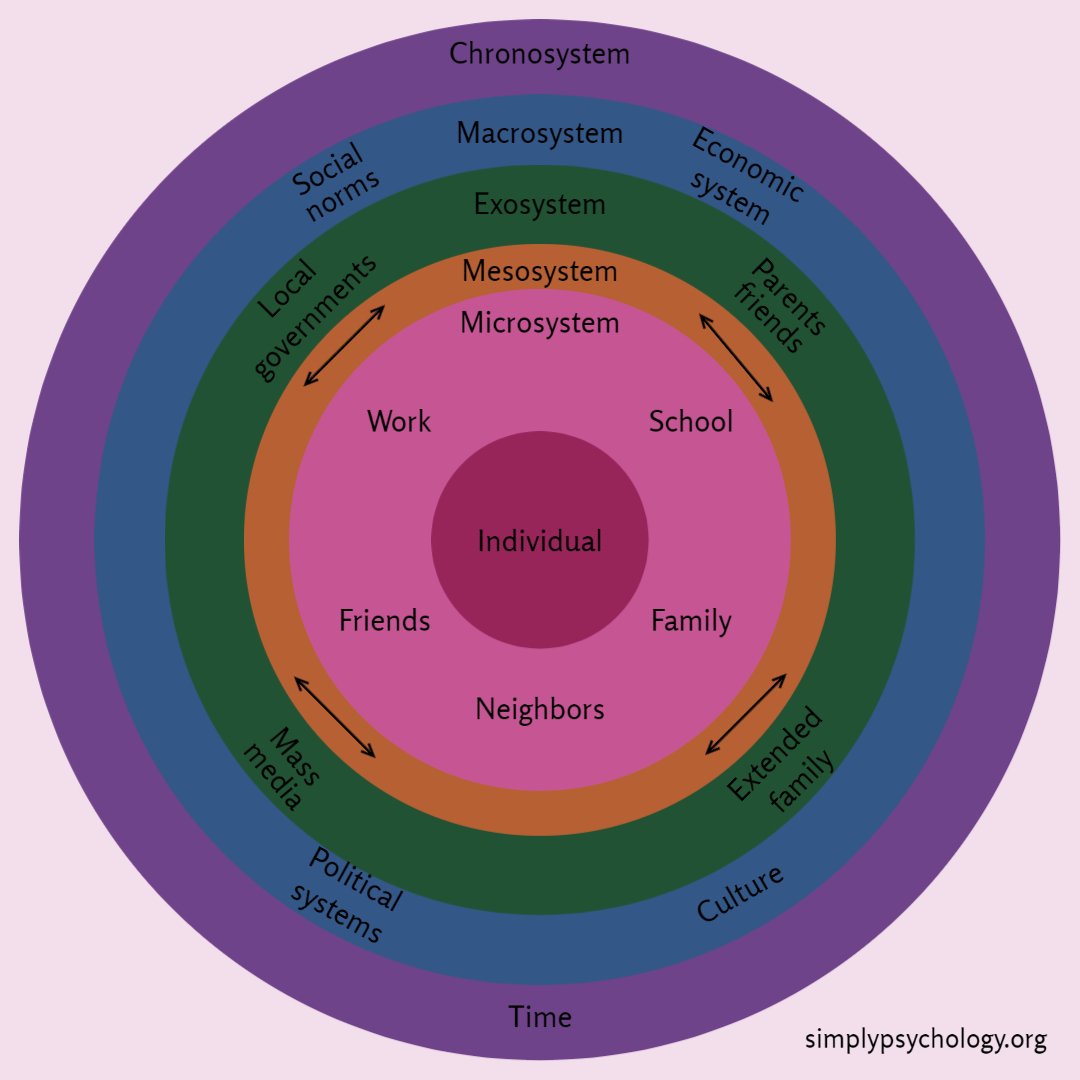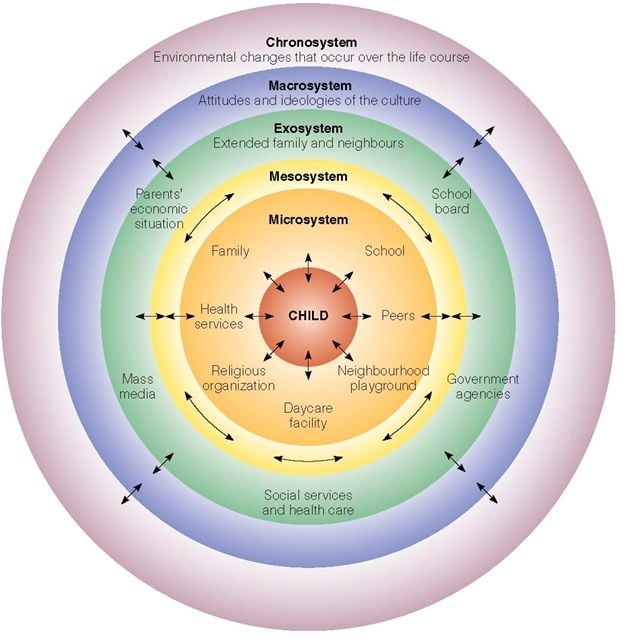On This Page:
Bronfenbrenner’s ecological systems theory posits that an individual’s development is influenced by a series of interconnected environmental systems, ranging from the immediate surroundings (e.g., family) to broad societal structures (e.g., culture).
These systems include the microsystem, mesosystem, exosystem, macrosystem, and chronosystem, each representing different levels of environmental influences on an individual’s growth and behavior.
Key Takeaways
- Bronfenbrenner’s ecological systems theory views child development as a complex system of relationships affected by multiple levels of the surrounding environment, from immediate family and school settings to broad cultural values, laws, and customs.
- To study a child’s development, we must look at the child and their immediate environment and the interaction of the larger environment.
- Bronfenbrenner divided the person’s environment into five different systems: the microsystem, the mesosystem, the exosystem, the macrosystem, and the chronosystem.
- The microsystem is the most influential level of the ecological systems theory. This is the most immediate environmental setting containing the developing child, such as family and school.
- Bronfenbrenner’s ecological systems theory has implications for educational practice.

The Five Ecological Systems
Bronfenbrenner (1977) suggested that the child’s environment is a nested arrangement of structures, each contained within the next. He organized them in order of how much of an impact they have on a child.
He named these structures the microsystem, mesosystem, exosystem, macrosystem and the chronosystem.
Because the five systems are interrelated, the influence of one system on a child’s development depends on its relationship with the others.
1. The Microsystem
The microsystem is the first level of Bronfenbrenner’s theory and is the things that have direct contact with the child in their immediate environment.
It includes the child’s most immediate relationships and environments. For example, a child’s parents, siblings, classmates, teachers, and neighbors would be part of their microsystem.
Relationships in a microsystem are bi-directional, meaning other people can influence the child in their environment and change other people’s beliefs and actions. The interactions the child has with these people and environments directly impact development.
For instance, supportive parents who read to their child and provide educational activities may positively influence cognitive and language skills. Or children with friends who bully them at school might develop self-esteem issues. The child is not just a passive recipient but an active contributor in these bidirectional interactions.
2. The Mesosystem
The mesosystem is where a person’s individual microsystems do not function independently but are interconnected and assert influence upon one another.
The mesosystem involves interactions between different microsystems in the child’s life. For example, open communication between a child’s parents and teachers provides consistency across both environments.
However, conflict between these microsystems, like parents and teachers blaming each other for a child’s poor grades, creates tension that negatively impacts the child.
The mesosystem can also involve interactions between peers and family. If a child’s friends use drugs, this may introduce substance use into the family microsystem. Or if siblings do not get along, this can spill over to peer relationships.
3. The Exosystem
The exosystem is a component of the ecological systems theory developed by Urie Bronfenbrenner in the 1970s.
It incorporates other formal and informal social structures. While not directly interacting with the child, the exosystem still influences the microsystems.
For instance, a parent’s stressful job and work schedule affects their availability, resources, and mood at home with their child. Local school board decisions about funding and programs impact the quality of education the child receives.
Even broader influences like government policies, mass media, and community resources shape the child’s microsystems.
For example, cuts to arts funding at school could limit a child’s exposure to music and art enrichment. Or a library bond could improve educational resources in the child’s community. The child does not directly interact with these structures, but they shape their microsystems.
4. The Macrosystem
The macrosystem focuses on how cultural elements affect a child’s development, consisting of cultural ideologies, attitudes, and social conditions that children are immersed in.
The macrosystem differs from the previous ecosystems as it does not refer to the specific environments of one developing child but the already established society and culture in which the child is developing.
Beliefs about gender roles, individualism, family structures, and social issues establish norms and values that permeate a child’s microsystems. For example, boys raised in patriarchal cultures might be socialized to assume domineering masculine roles.
Socioeconomic status also exerts macro-level influence – children from affluent families will likely have more educational advantages versus children raised in poverty.
Even within a common macrosystem, interpretations of norms differ – not all families from the same culture hold the same values or norms.
5. The Chronosystem
The fifth and final level of Bronfenbrenner’s ecological systems theory is known as the chronosystem.
The chronosystem relates to shifts and transitions over the child’s lifetime. These environmental changes can be predicted, like starting school, or unpredicted, like parental divorce or changing schools when parents relocate for work, which may cause stress.
Historical events also fall within the chronosystem, like how growing up during a recession may limit family resources or growing up during war versus peacetime also fall in this system.
As children get older and enter new environments, both physical and cognitive changes interact with shifting social expectations. For example, the challenges of puberty combined with transition to middle school impact self-esteem and academic performance.
Aging itself interacts with shifting social expectations over the lifespan within the chronosystem.
How children respond to expected and unexpected life transitions depends on the support of their ecological systems.
The Bioecological Model
It is important to note that Bronfenbrenner (1994) later revised his theory and instead named it the ‘Bioecological model’.
Bronfenbrenner became more concerned with the proximal development processes, meaning the enduring and persistent forms of interaction in the immediate environment.
His focus shifted from environmental influences to developmental processes individuals experience over time.
‘…development takes place through the process of progressively more complex reciprocal interactions between an active, evolving biopsychological human organism and the persons, objects, and symbols in its immediate external environment.’ (Bronfenbrenner, 1995).
Bronfenbrenner also suggested that to understand the effect of these proximal processes on development, we have to focus on the person, context, and developmental outcome, as these processes vary and affect people differently (Bronfenbrenner & Evans, 2000).
While his original ecological systems theory emphasized the role of environmental systems, his later bioecological model focused more closely on micro-level interactions.
The bioecological shift highlighted reciprocal processes between the actively evolving individual and their immediate settings. This represented an evolution in Bronfenbrenner’s thinking toward a more dynamic developmental process view.
However, the bioecological model still acknowledged the broader environmental systems from his original theory as an important contextual influence on proximal processes.
The bioecological focus on evolving person-environment interactions built upon the foundation of his ecological systems theory while bringing developmental processes to the forefront.
Classroom Application
The Ecological Systems Theory has been used to link psychological and educational theory to early educational curriculums and practice. The developing child is at the center of the theory, and all that occurs within and between the five ecological systems are done to benefit the child in the classroom.
- According to the theory, teachers and parents should maintain good communication with each other and work together to benefit the child to strengthen the development of the ecological systems in educational practice.
- Teachers should also be understanding of the situations their student’s families may be experiencing, including social and economic factors that are part of the various systems.
- According to the theory, if parents and teachers have a good relationship, this should positively shape the child’s development.
- Likewise, the child must be active in their learning, both academically and socially. They must collaborate with their peers and participate in meaningful learning experiences to enable positive development (Evans, 2012).

There are lots of studies that have investigated the effects of the school environment on students. Below are some examples:
Lippard, LA Paro, Rouse, and Crosby (2017) conducted a study to test Bronfenbrenner’s theory. They investigated the teacher-child relationships through teacher reports and classroom observations.
They found that these relationships were significantly related to children’s academic achievement and classroom behavior, suggesting that these relationships are important for children’s development and supports the Ecological Systems Theory.
Wilson et al. (2002) found that creating a positive school environment through a school ethos valuing diversity has a positive effect on students’ relationships within the school. Incorporating this kind of school ethos influences those within the developing child’s ecological systems.
Langford et al. (2014) found that whole-school approaches to the health curriculum can positively improve educational achievement and student well-being. Thus, the development of the students is being affected by the microsystems.
Critical Evaluation
Strengths
Bronfenbrenner’s model quickly became very appealing and accepted as a useful framework for psychologists, sociologists, and teachers studying child development.
The Ecological Systems Theory provides a holistic approach that is inclusive of all the systems children and their families are involved in, accurately reflecting the dynamic nature of actual family relationships (Hayes & O’Toole, 2017).
Paat (2013) considers how Bronfenbrenner’s theory is useful when it comes to the development of immigrant children. They suggest that immigrant children’s experiences in the various ecological systems are likely to be shaped by their cultural differences. Understanding these children’s ecology can aid in strengthening social work service delivery for these children.
Limitations
A limitation of the Ecological Systems Theory is that there is limited research examining the mesosystems, mainly the interactions between neighborhoods and the family of the child (Leventhal & Brooks-Gunn, 2000). Therefore, the extent to which these systems can shape child development is unclear.
Another limitation of Bronfenbrenner’s theory is that it is difficult to empirically test the theory. The studies investigating the ecological systems may establish an effect, but they cannot establish whether the systems directly cause such effects.
Furthermore, this theory can lead to assumptions that those who do not have strong and positive ecological systems lack in development. Whilst this may be true in some cases, many people can still develop into well-rounded individuals without positive influences from their ecological systems.
For instance, it is not true to say that all people who grow up in poverty-stricken areas of the world will develop negatively. Similarly, if a child’s teachers and parents do not get along, some children may not experience any negative effects if it does not concern them.
As a result, people need to avoid making broad assumptions about individuals using this theory.
How Relevant is Bronfenbrenner’s Theory in the 21st Century?
The world has greatly changed since this theory was introduced, so it’s important to consider whether Bronfenbrenner’s theory is still relevant today.
Kelly and Coughlan (2019) used constructivist grounded theory analysis to develop a theoretical framework for youth mental health recovery and found that there were many links to Bronfenbrenner’s ecological systems theory in their own more recent theory.
Their theory suggested that the components of mental health recovery are embedded in the ‘ecological context of influential relationships,’ which fits in with Bronfenbrenner’s theory that the ecological systems of the young person, such as peers, family, and school, all help mental health development.
We should also consider whether Bronfenbrenner’s theory fits in with advanced technological advancements in the 21st century. It could be that the ecological systems are still valid but may expand over time to include new modern developments.
The exosystem of a child, for instance, could be expanded to consider influences from social media, video gaming, and other modern-day interactions within the ecological system.
Neo-ecological theory
Navarro & Tudge (2022) proposed the neo-ecological theory, an adaptation of the bioecological theory. Below are their main ideas for updating Bronfenbrenner’s theory to the technological age:
- Virtual microsystems should be added as a new type of microsystem to account for online interactions and activities. Virtual microsystems have unique features compared to physical microsystems, like availability, publicness, and asychnronicity.
- The macrosystem (cultural beliefs, values) is an important influence, as digital technology has enabled youth to participate more in creating youth culture and norms.
- Proximal processes, the engines of development, can now happen through complex interactions with both people and objects/symbols online. So, proximal processes in virtual microsystems need to be considered.
Background
Urie Bronfenbrenner was born in Moscow, Russia, in 1917 and experienced turmoil in his home country as a child before immigrating to the United States at age 6.
Witnessing the difficulties faced by children during the unrest and rapid social change in Russia shaped his ideas about how environmental factors can influence child development.
Bronfenbrenner went on to earn a Ph.D. in developmental psychology from the University of Michigan in 1942.
At the time, most child psychology research involved lab experiments with children briefly interacting with strangers.
Bronfenbrenner criticized this approach as lacking ecological validity compared to real-world settings where children live and grow. For example, he cited Mary Ainsworth’s 1970 “Strange Situation” study, which observed infants with caregivers in a laboratory.
Bronfenbrenner argued that these unilateral lab studies failed to account for reciprocal influence between variables or the impact of broader environmental forces.
His work challenged the prevailing views by proposing that multiple aspects of a child’s life interact to influence development.
In the 1970s, drawing on foundations from theories by Vygotsky, Bandura, and others acknowledging environmental impact, Bronfenbrenner articulated his groundbreaking Ecological Systems Theory.
This framework mapped children’s development across layered environmental systems ranging from immediate settings like family to broad cultural values and historical context.
Bronfenbrenner’s ecological perspective represented a major shift in developmental psychology by emphasizing the role of environmental systems and broader social structures in human development.
The theory sparked enduring influence across many fields, including psychology, education, and social policy.
Frequently Asked Questions
What is the main contribution of Bronfenbrenner’s theory?
The Ecological Systems Theory has contributed to our understanding that multiple levels influence an individual’s development rather than just individual traits or characteristics.
Bronfenbrenner contributed to the understanding that parent-child relationships do not occur in a vacuum but are embedded in larger structures.
Ultimately, this theory has contributed to a more holistic understanding of human development, and has influenced fields such as psychology, sociology, and education.
What could happen if a child’s microsystem breaks down?
If a child experiences conflict or neglect within their family, or bullying or rejection by their peers, their microsystem may break down. This can lead to a range of negative outcomes, such as decreased academic achievement, social isolation, and mental health issues.
Additionally, if the microsystem is not providing the necessary support and resources for the child’s development, it can hinder their ability to thrive and reach their full potential.
How can the Ecological System’s Theory explain peer pressure?
The ecological systems theory explains peer pressure as a result of the microsystem (immediate environment) and mesosystem (connections between environments) levels.
Peers provide a sense of belonging and validation in the microsystem, and when they engage in certain behaviors or hold certain beliefs, they may exert pressure on the child to conform. The mesosystem can also influence peer pressure, as conflicting messages and expectations from different environments can create pressure to conform.
References
Bronfenbrenner, U. (1974). Developmental research, public policy, and the ecology of childhood. Child development, 45 (1), 1-5.
Bronfenbrenner, U. (1977). Toward an experimental ecology of human development. American psychologist, 32 (7), 513.
Bronfenbrenner, U. (1995). Developmental ecology through space and time: A future perspective.
Bronfenbrenner, U., & Evans, G. W. (2000). Developmental science in the 21st century: Emerging questions, theoretical models, research designs and empirical findings . Social development, 9 (1), 115-125.
Bronfenbrenner, U., & Ceci, S. J. (1994). Nature-nurture reconceptualised: A bio-ecological model. Psychological Review, 10 (4), 568–586.
Hayes, N., O’Toole, L., & Halpenny, A. M. (2017). Introducing Bronfenbrenner: A guide for practitioners and students in early years education. Taylor & Francis.
Kelly, M., & Coughlan, B. (2019). A theory of youth mental health recovery from a parental perspective. Child and Adolescent Mental Health, 24 (2), 161-169.
Langford, R., Bonell, C. P., Jones, H. E., Pouliou, T., Murphy, S. M., Waters, E., Komro, A. A., Gibbs, L. F., Magnus, D. & Campbell, R. (2014). The WHO Health Promoting School framework for improving the health and well‐being of students and their academic achievement. Cochrane database of systematic reviews, (4).
Leventhal, T., & Brooks-Gunn, J. (2000). The neighborhoods they live in: the effects of neighborhood residence on child and adolescent outcomes. Psychological Bulletin, 126 (2), 309.
Lippard, C. N., La Paro, K. M., Rouse, H. L., & Crosby, D. A. (2018, February). A closer look at teacher–child relationships and classroom emotional context in preschool. In Child & Youth Care Forum 47(1), 1-21.
Navarro, J. L., & Tudge, J. R. (2022). Technologizing Bronfenbrenner: neo-ecological theory. Current Psychology, 1-17.
Paat, Y. F. (2013). Working with immigrant children and their families: An application of Bronfenbrenner’s ecological systems theory. Journal of Human Behavior in the Social Environment, 23 (8), 954-966.
Rhodes, S. (2013). Bronfenbrenner’s Ecological Theory [PDF]. Retrieved from http://uoit.blackboard.com
Wilson, P., Atkinson, M., Hornby, G., Thompson, M., Cooper, M., Hooper, C. M., & Southall, A. (2002). Young minds in our schools-a guide for teachers and others working in schools. Year: YoungMinds (Jan 2004).
Further Information


